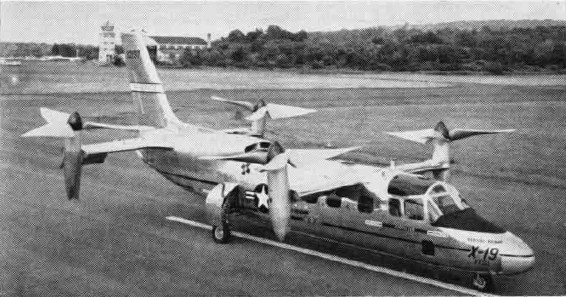Curtiss-Wright X-19 on:
[Wikipedia]
[Google]
[Amazon]
The Curtiss-Wright X-19, company designation Model 200, was an American experimental
"Aircraft list."
''National Museum of the United States Air Force.'' Retrieved: 17 June 2012. The power transmission,

Curtiss-Wright X-19 Background
{{Authority control Tandem-wing aircraft Tiltrotor aircraft X-19, Curtiss-Wright X-19 Quadrotors Aircraft first flown in 1963
tiltrotor aircraft
A tiltrotor is an aircraft which generates lift and propulsion by way of one or more powered rotors (sometimes called ''proprotors'') mounted on rotating shafts or nacelles usually at the ends of a fixed wing. Almost all tiltrotors use a trans ...
of the early 1960s. It was noteworthy for being the last aircraft of any kind manufactured by Curtiss-Wright.
Design and development
In March 1960 the Curtiss-Wright Corporation developed the X-100, aprototype
A prototype is an early sample, model, or release of a product built to test a concept or process. It is a term used in a variety of contexts, including semantics, design, electronics, and Software prototyping, software programming. A prototyp ...
for a new, vertical takeoff transport aircraft. The X-100 had a single turboshaft engine
A turboshaft engine is a form of gas turbine that is optimized to produce shaftpower rather than jet thrust. In concept, turboshaft engines are very similar to turbojets, with additional turbine expansion to extract heat energy from the exhaust ...
, which propelled two tilting-propellers, while at the tail swivelling nozzles used the engine's exhaust gases to give additional control for hovering or slow flight. Although sometimes classified as a tiltrotor aircraft, the design differed from the Bell VTOL XV tiltrotor designs. The X-19 utilized specially designed radial lift propellers, rather than helicopter-like rotors, for vertical takeoff and augmenting the lift provided by the wing structures.
From the X-100 Curtiss-Wright developed the larger X-200, of which the United States Air Force
The United States Air Force (USAF) is the air service branch of the United States Armed Forces, and is one of the eight uniformed services of the United States. Originally created on 1 August 1907, as a part of the United States Army Signal ...
ordered two prototypes designated the X-19A.
The X-19 had fore and aft high-mounted tandem wing QAC Quickie Q2
A tandem wing is a wing configuration in which a flying craft or animal has two or more sets of wings set one behind another. All the wings contribute to lift.
The tandem wing is distinct from the biplane in which the wings are s ...
s. Each wing mounted two propellers
A propeller (colloquially often called a screw if on a ship or an airscrew if on an aircraft) is a device with a rotating hub and radiating blades that are set at a pitch to form a helical spiral which, when rotated, exerts linear thrust upon ...
that could be rotated through 90 degrees, allowing the aircraft to take off and land like a helicopter
A helicopter is a type of rotorcraft in which lift and thrust are supplied by horizontally spinning rotors. This allows the helicopter to take off and land vertically, to hover, and to fly forward, backward and laterally. These attributes ...
. The propellers were driven by twin Avco Lycoming T55-L-5 turboshaft engines mounted in the fuselage
The fuselage (; from the French ''fuselé'' "spindle-shaped") is an aircraft's main body section. It holds crew, passengers, or cargo. In single-engine aircraft, it will usually contain an engine as well, although in some amphibious aircraft t ...
.
Operational history
The first flight of the X-19 took place in November 1963 (other sources give 26 June 1964). It was intended that the X-19 would be developed into a VTOL transport aircraft. However the first X-19 was destroyed in a crash on 25 August 1965, with no loss of life, and the program was subsequently cancelled; the second prototype was never completed. The second X-19 prototype is currently being stored in the restoration facilities at theNational Museum of the United States Air Force
The National Museum of the United States Air Force (formerly the United States Air Force Museum) is the official museum of the United States Air Force located at Wright-Patterson Air Force Base, northeast of Dayton, Ohio. The NMUSAF is the ...
in Dayton, Ohio
Dayton () is the sixth-largest city in the U.S. state of Ohio and the county seat of Montgomery County. A small part of the city extends into Greene County. The 2020 U.S. census estimate put the city population at 137,644, while Greater Day ...
.''National Museum of the United States Air Force.'' Retrieved: 17 June 2012. The power transmission,
power to weight
Power-to-weight ratio (PWR, also called specific power, or power-to-mass ratio) is a calculation commonly applied to engines and mobile power sources to enable the comparison of one unit or design to another. Power-to-weight ratio is a measuremen ...
requirements, flight mode transition and multi-axis control make VTOL aircraft design far more problematic than conventional fixed wing and even helicopter design. Like most pioneering tilt aircraft, the aerodynamic complexity of coupled pitch, roll, and yaw, and torque, particularly in transition from vertical takeoff to horizontal flight, made design of the X-19 extremely challenging. Ultimately, weaknesses in the power transmission gear boxes led to failure. Owing to design complexity, tiltrotor VTOL aircraft did not enter operational service until the Bell-Boeing V-22 Osprey
The Bell Boeing V-22 Osprey is an American multi-mission, tiltrotor military aircraft with both vertical takeoff and landing (VTOL) and short takeoff and landing (STOL) capabilities. It is designed to combine the functionality of a convention ...
introduction in 2007.
Specifications (X-19)

See also
References
External links
Curtiss-Wright X-19 Background
{{Authority control Tandem-wing aircraft Tiltrotor aircraft X-19, Curtiss-Wright X-19 Quadrotors Aircraft first flown in 1963